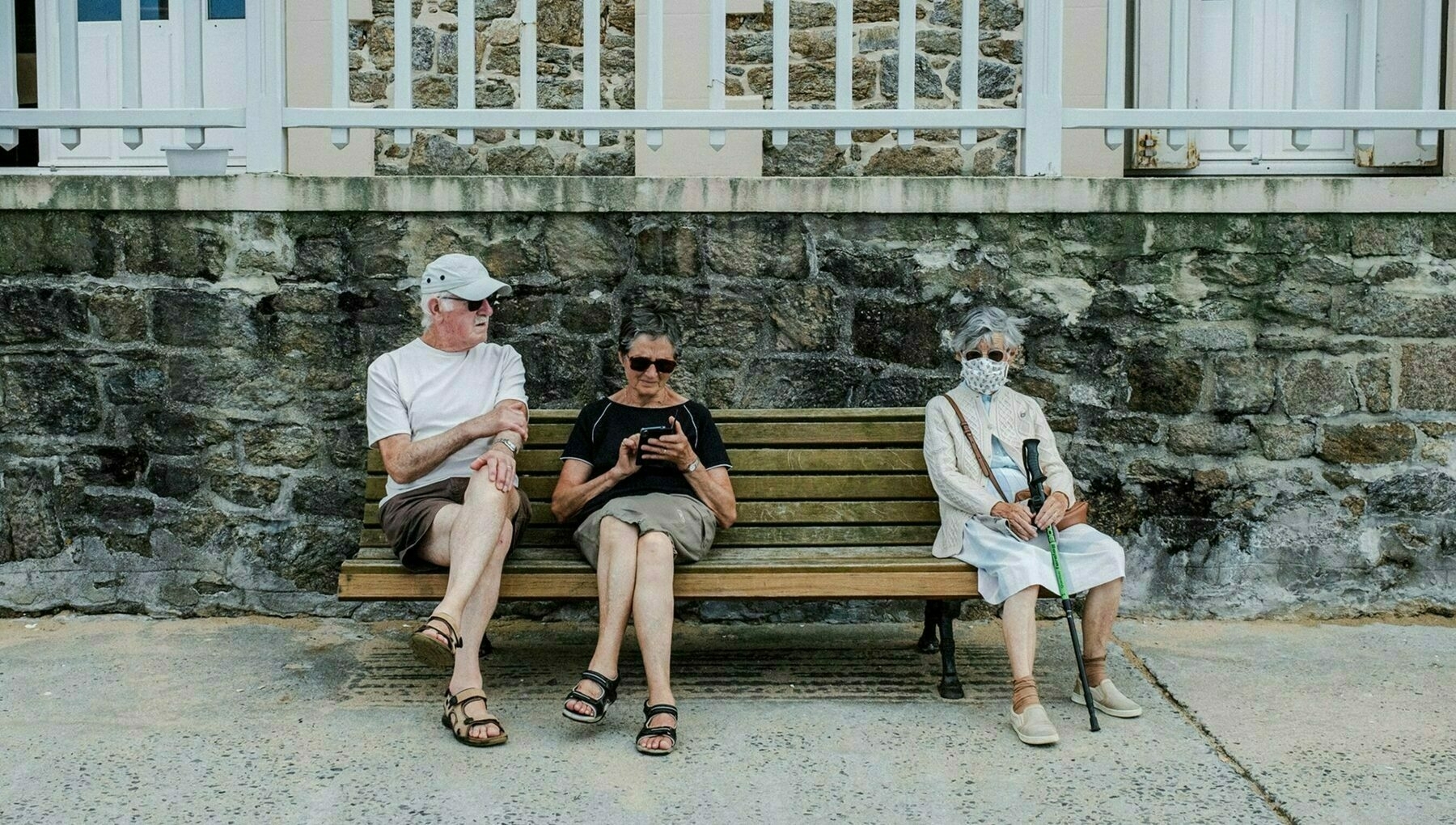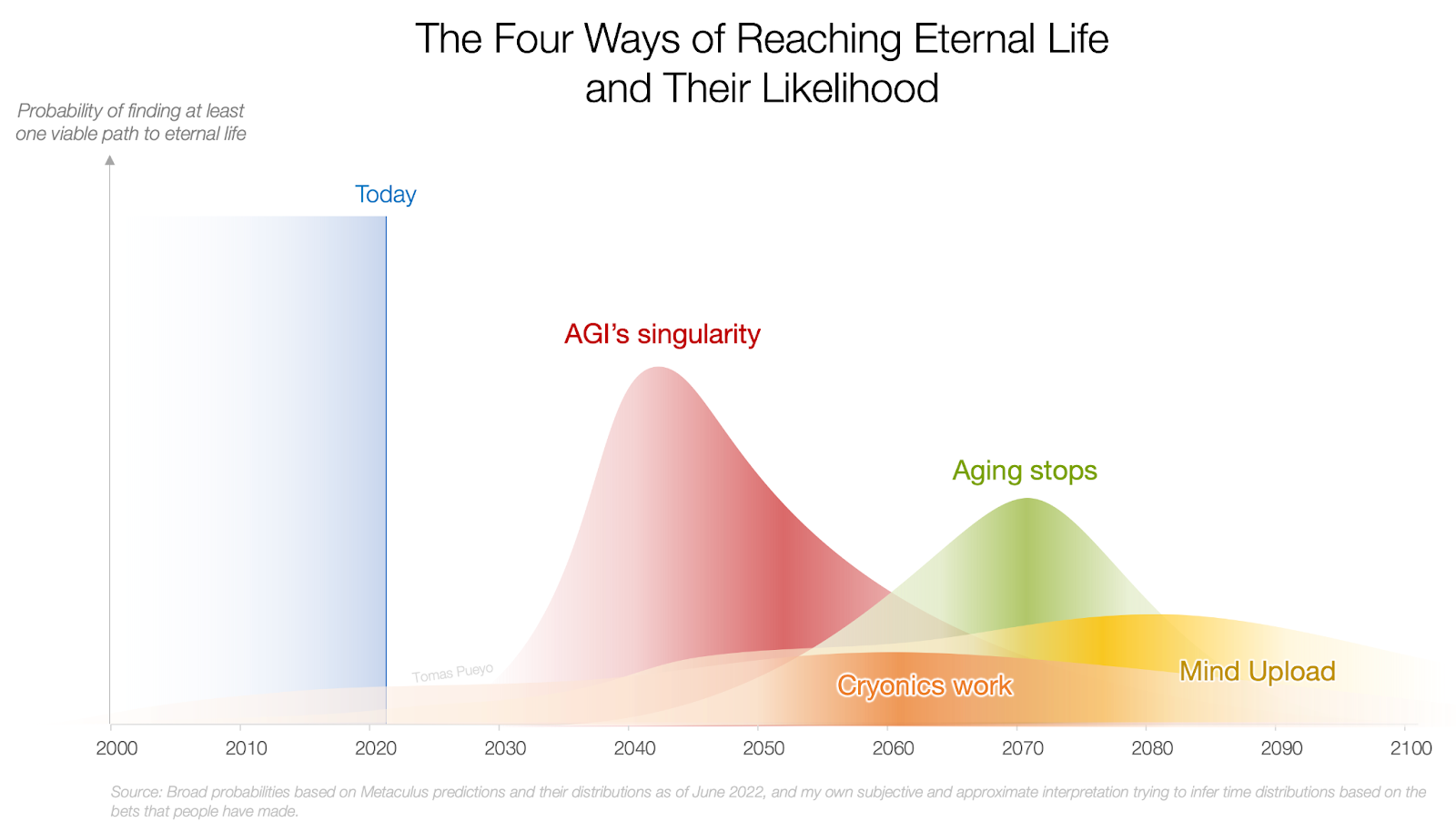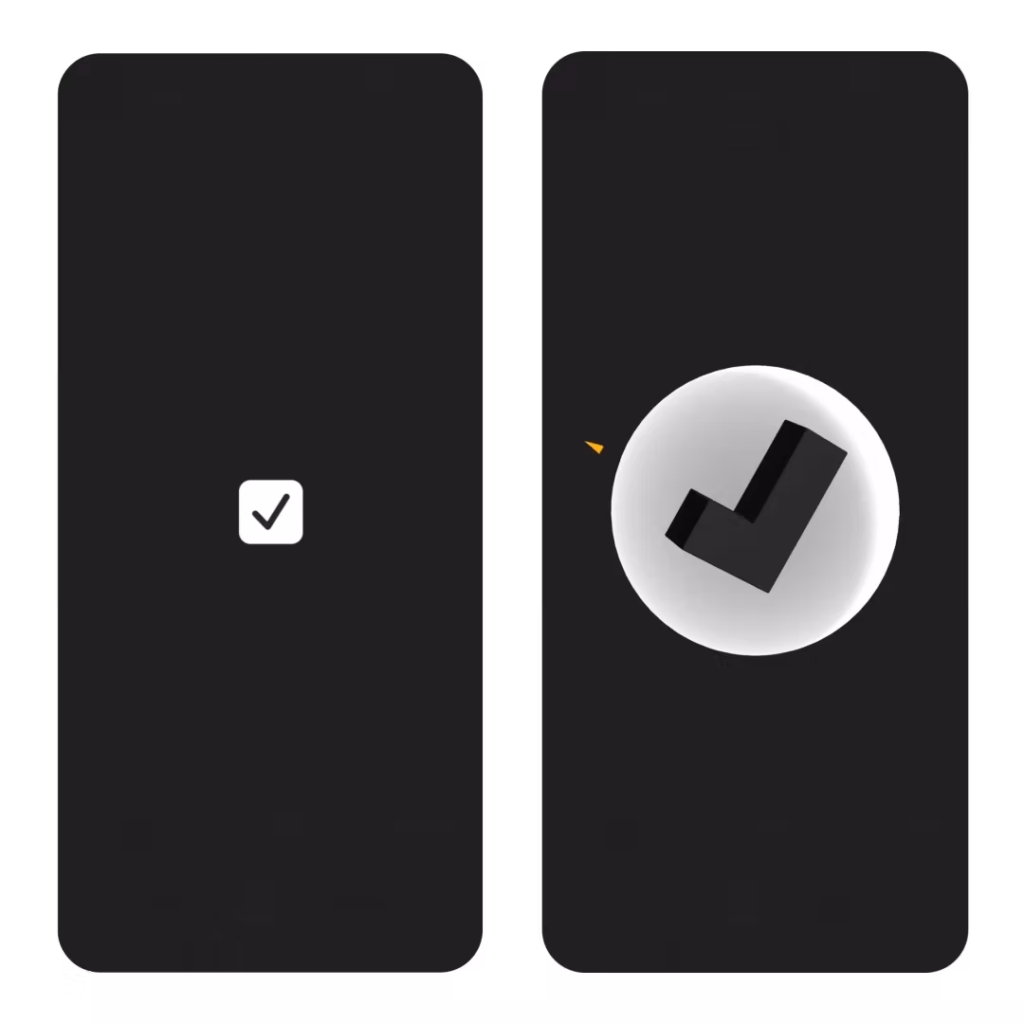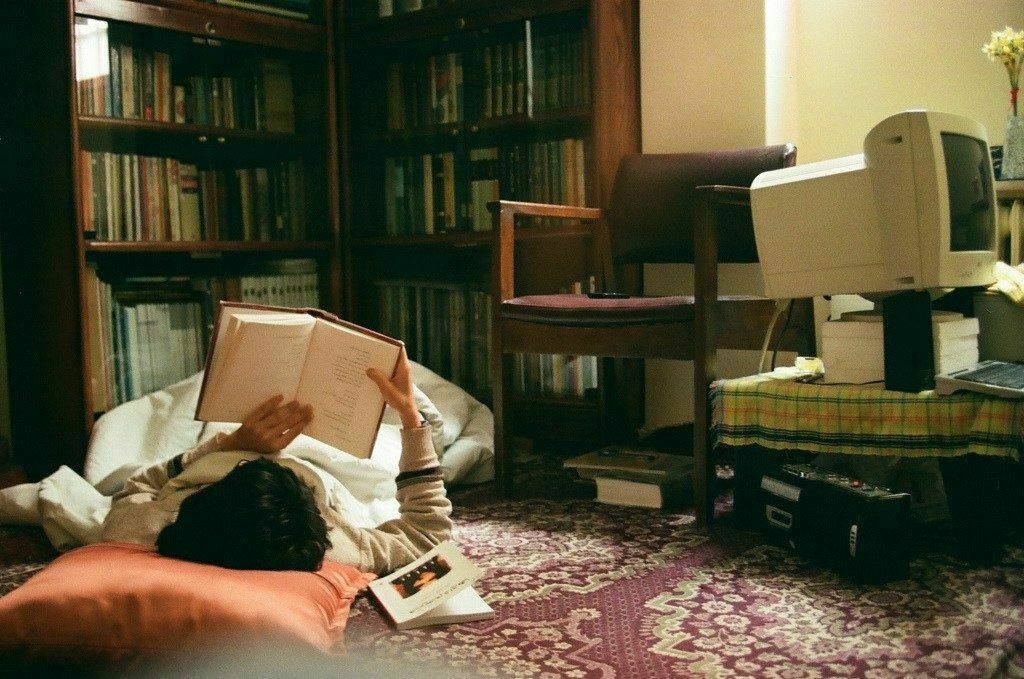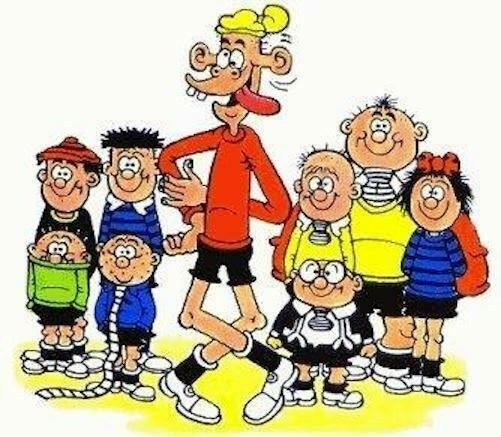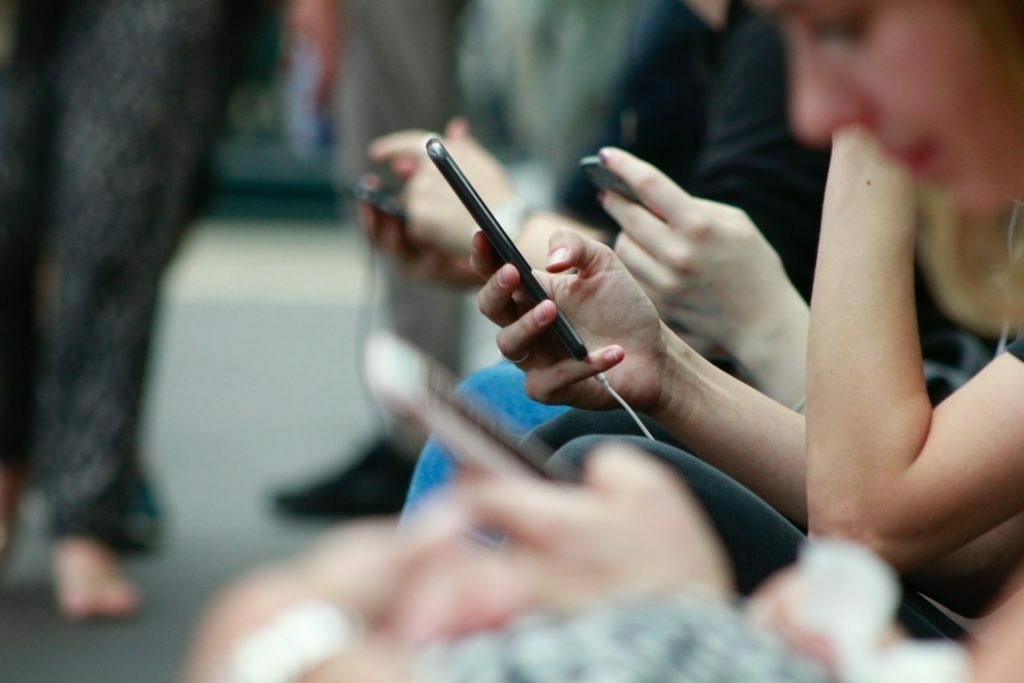2022
- Higher income & education demographics - Information-seeking traffic predominates, e.g., news, mail, search; Instagram, WhatsApp and Twitter are the dominant social media apps; games like Clash of Clans are the most widely used, …
- Lower income & education demographics - Entertainment traffic predominates, e.g., video-streaming, gaming, adult services; Facebook and Snapchat are the dominant social media apps; games like Candy Crush are the most widely used, …
The internet is broken because the internet is a business
I ended up cancelling my Verso books subscription because I was overwhelmed with the number of amazing books coming out every month. This looks like one to keep an eye out for.
Several decades into our experiment with the internet, we appear to have reached a crossroads. The connection that it enables and the various forms of interaction that grow out of it have undoubtedly brought benefits. People can more easily communicate with the people they love, access knowledge to keep themselves informed or entertained, and find myriad new opportunities that otherwise might have been out of reach.Source: The Privatized Internet Has Failed Us | JacobinBut if you ask people today, for all those positive attributes, they’re also likely to tell you that the internet has several big problems. The new Brandeisian movement calling to “break up Big Tech” will say that the problem is monopolization and the power that major tech companies have accrued as a result. Other activists may frame the problem as the ability of companies or the state to use the new tools offered by this digital infrastructure to intrude on our privacy or restrict our ability to freely express ourselves. Depending on how the problem is defined, a series of reforms are presented that claim to rein in those undesirable actions and get companies to embrace a more ethical digital capitalism.
There’s certainly some truth to the claims of these activists, and aspects of their proposed reforms could make an important difference to our online experiences. But in his new book ‘Internet for the People: The Fight for Our Digital Future’, Ben Tarnoff argues that those criticisms fail to identify the true problem with the internet. Monopolization, surveillance, and any number of other issues are the product of a much deeper flaw in the system.
“The root is simple,” writes Tarnoff: “The internet is broken because the internet is a business.”
The ultimate act of self-denial
This is absolutely wild.
Scattered throughout northern Japan are over two dozen mummified Japanese monks known as sokushinbutsu. Followers of shugendō, an ancient form of Buddhism, the monks died in the ultimate act of self-denial.Source: Sokushinbutsu of Dainichibou Temple | Atlas ObscuraFor three years, the priests would eat a special diet consisting only of nuts and seeds, while taking part in a regimen of rigorous physical activity that stripped them of their body fat. They then ate only bark and roots for another three years and began drinking a poisonous tea made from the sap of the urushi tree, normally used to lacquer bowls. This caused vomiting and a rapid loss of bodily fluids, and—most importantly—it killed off any maggots that might cause the body to decay after death. Finally, a self-mummifying monk would lock himself in a stone tomb barely larger than his body, wherein he would not move from the lotus position. His only connection to the outside world was an air tube and a bell. Each day, he rang a bell to let those outside know that he was still alive. When the bell stopped ringing, the tube was removed and the tomb sealed.
Muting the American internet
This is a humorous article, but one with a point.
[W]e need a way to mute America. Why? Because America has no chill. America is exhausting. America is incapable of letting something be simply funny instead of a dread portent of their apocalyptic present. America is ruining the internet.Source: I Should Be Able to Mute America | Gawker[…]
The greatest trick America’s ever pulled on the subjects of its various vassal states is making us feel like a participant in its grand experiment. After all, our fate is bound to the American empire’s whale fall. My generation in particular is the first pure batch of Yankee-Yobbo mutoids: as much Hank Hill as we are Hills Hoist (look it up!), as familiar with the Supreme Court Justices as we are with the judges on Master Chef, as comfortable in Frasier’s Seattle or Seinfeld’s Upper West Side as we are in Ramsay Street or Summer Bay.
[…]
I should not know who Pete Buttigieg is. In a just world, the name Bari Weiss would mean as much to me as Nordic runes. This goes for people who actually might read Nordic runes too. No Swede deserves to be burdened with this knowledge. No Brazilian should have to regularly encounter the phrase “Dimes Square.” To the rest of the vast and varied world, My Pillow Guy and Papa John should be NPCs from a Nintendo DS Zelda title, not men of flesh and bone, pillow and pizza. Ted Cruz should be the name of an Italian pornstar in a Love Boat porn parody. Instead, I’m cursed to know that he is a senator from Texas who once stood next to a butter sculpture of a dairy cow and declared that his daughter’s first words were “I like butter.”
Muting the American internet
This is a humorous article, but one with a point.
[W]e need a way to mute America. Why? Because America has no chill. America is exhausting. America is incapable of letting something be simply funny instead of a dread portent of their apocalyptic present. America is ruining the internet.Source: I Should Be Able to Mute America | Gawker[…]
The greatest trick America’s ever pulled on the subjects of its various vassal states is making us feel like a participant in its grand experiment. After all, our fate is bound to the American empire’s whale fall. My generation in particular is the first pure batch of Yankee-Yobbo mutoids: as much Hank Hill as we are Hills Hoist (look it up!), as familiar with the Supreme Court Justices as we are with the judges on Master Chef, as comfortable in Frasier’s Seattle or Seinfeld’s Upper West Side as we are in Ramsay Street or Summer Bay.
[…]
I should not know who Pete Buttigieg is. In a just world, the name Bari Weiss would mean as much to me as Nordic runes. This goes for people who actually might read Nordic runes too. No Swede deserves to be burdened with this knowledge. No Brazilian should have to regularly encounter the phrase “Dimes Square.” To the rest of the vast and varied world, My Pillow Guy and Papa John should be NPCs from a Nintendo DS Zelda title, not men of flesh and bone, pillow and pizza. Ted Cruz should be the name of an Italian pornstar in a Love Boat porn parody. Instead, I’m cursed to know that he is a senator from Texas who once stood next to a butter sculpture of a dairy cow and declared that his daughter’s first words were “I like butter.”
Morality, responsibility, and (online) information
This is a useful article in terms of thinking about the problems we have around misinformation online. Yes, we have a responsibility to be informed citizens, but there are structural issues which are actively working against that.
How might we alleviate our society’s misinformation problem? One suggestion goes as follows: the problem is that people are so ignorant, poorly informed, gullible, irrational that they lack the ability to discern credible information and real expertise from incredible information and fake expertise.Source: On the moral responsibility to be an informed citizen | Psyche Ideas[…]
This view places the primary responsibility for our current informational predicament – and the responsibility to mend it – on individuals. It views them as somehow cognitively deficient. An attractive aspect of this view is that it suggests a solution (people need to become smarter) directly where the problem seems to lie (people are not smart). Simply, if we want to stop the spread of misinformation, people need to take responsibility to think better and learn how to stop spreading it. A closer philosophical and social scientific look at issues of responsibility with regard to information suggests that this view is mistaken on several accounts.
[…]
Even if there was a mass willingness to accept accountability, or if a responsibility could be articulated without blaming citizens, there is no guarantee that citizens would be successful in actually practising their responsibility to be informed. As I said, even the best intentions are often manipulated. Critical thinking, rationality and identifying the correct experts are extremely difficult things to practise effectively on their own, much less in warped information environments. This is not to say that people’s intentions are universally good, but that even sincere, well-meaning efforts do not necessarily have desirable outcomes. This speaks against proposing a greater individual responsibility for misinformation, because, if even the best intentions can be corrupted, then there isn’t a great chance of success.
[…]
Leaning away from individual responsibility means that the burden should be shifted to those who have structural control over our information environments. Solutions to our misinformation epidemic are effective when they are structural and address the problem at its roots. In the case of online misinformation, we should understand that technology giants aim at creating profit over creating public democratic goods. If disinformation can be made to be profitable, we should not expect those who profit to self-regulate and adopt a responsibility toward information by default. Placing accountability and responsibility on technology companies but also on government, regulatory bodies, traditional media and political parties by democratic means is a good first step to foster information environments that encourage good knowledge practices. This step provides a realistic distribution of both causal and effective remedial responsibility for our misinformation problem without nihilistically throwing out the entire concept of responsibility – which we should never do.
Living forever
The interesting thing about this article is the predictions from forecasters on the website Metaculus. There’s wisdom in crowds, and particularly those who have interest/expertise in a given area.
There are a million philosophical questions about ‘living forever’ or just humans living for a lot longer than they do now. This article, however, just focuses on the four most promising ways, and their likelihood over different timescales.
We’re either the last generation to ever die, or the first generation to live forever.Source: The 4 Ways You Might Live Forever | Tomas PueyoI’m not talking figuratively here. You, reading this, might have an eternal life.
Who knew tapping a checkbox could be so satisfying?
I love it when people who are great at what they do, and who sweat the details, share their processes. It’s well worth looking at the lengths this designer has gone to in order to make tapping a simple checkbox feel like an achievement. Visuals, sound, haptics, the lot!
These things matter. One of the reasons I like Trello so much, for example, is the confetti that emanates from the card when you drag it to ‘done’.
If we can add Feel to the humble checkbox, imagine what it could do for apps that aid in personal connections or creativity. Many of us make the mistake in thinking of the apps we design as public spaces—drawing inspiration from the rationality of airport signage or the deference of an art gallery. We completely forget that these experiences are also incredibly personal. And while a clean, white gallery space may be beautiful in its minimalism, it’s not the comforting place most would want to live.Source: The World’s Most Satisfying Checkbox | (Not Boring) SoftwareDesign can be reductive and rational. But it can also add richness to our lives.
Maximize that.
And use every tool you can get your hands on.
Subscriber count as power level against algorithmic demons
I’ve done a lot of writing for work this week and needed to hear some of the things in this post by Justin Murphy. Great stuff.
Mustering the discipline to write on a regular basis is a battle against yourself, against your own feeling that it doesn't matter.Source: Writing is a Single-Player Game | Other LifeFinding the will to click the publish button is a battle against yourself, against your own feeling that it’s not worth it.
You feel nervous about what your readers will think, but that makes no sense. They subscribed to you because they want to know what you think; you have zero reason to care what they think. If you really care what your readers think, then go subscribe to them. You are not subscribed to your readers because you do not care what they think. Now act like it.
Artificial metrics are flying by instrument
We had a conversation earlier this week about how we’re going to measure the progress of some community work we’re doing. In the end, we decided that there were no metrics that would make sense. It’s a vibe.
This post says much the same thing. Sometimes there are no objective measurements for things that matter. And that’s OK.
Artificial metrics are flying by instrument. They're individual "better/worse" dials that in amalgamation are supposed to tell you which way things are going, as long you are paying attention to the correct combination of them at the correct moment, and don't over-react to the feedback loops and crash the whole thing via a PIO. Instrument-only flight is harder than visual flight, it takes extensive practice, and the mistakes have worse repercussions.Source: How to build orgs that achieve your goals, by absolutely never doing that | Graham says wrong thingsYou can instead choose to just fly visually. It’s easier, it’s safer, and it’ll get you where you’re trying to go. The thing is, your entire industry thinks it’s impossible, and worse, they think it is irresponsible. They’re kinda right. You have to be good at the innate skill of flying, instead of the skill of navigating by instrument. Guess which one the “become a manager in tech” system produces. Bonus points: recognize how that is itself a PIO.
Bonus Bonus Bonus points: Consider that if you’ve learned the skillset of visual flight poorly, and you don’t use the instruments to correct yourself, how will you ever know it’s going wrong in time?
[…]
What matters for your team/org’s success is the fundamental human relationships, comradery, esprit de corps, support and space-curation, and especially, all of the prior while treating-em-like-adults. Those things make up the totality of why people want to work on your team and are excited about working with and supporting their peers. These are not invisible things. These are things you can pay attention to, structurally. These are not things you can quantify with numbers. You’re going to have to get comfortable with forming, expressing, and defending opinions based on things besides “data.” Not because you don’t have data, but because you don’t have quantifiable numbers that represent themselves, and our industry is poisoned into believing that only such things are data. We’ve got thousands of years of evolution helping us understand how group dynamics are flowing. Yes, using that is a skill set. That’s my point. Build and use that skill set. Learn how to read people’s reactions. Learn how to understand people’s motivations. Learn how to see how people work in groups and as individuals. Do the work.
Image: Jp Valery
Audrey Watters says goodbye to EdTech
Sadly, EdTech, the field that I used to feel part of, is never going to change, so this post from Audrey Watters was sadly inevitable. Anything that can be commodified will be commodified, it would seem.
Thanks Audrey, you’re awesome. I hope you find solace and energy in what you decide to do next.
I probably do have a wee bit more to say about ed-tech — the "good riddance" part — but I don't feel like posting it on Hack Education. I'll write about it here — therapeutically, I reckon. But I don't really want to continue to churn out criticism of the field/industry/discipline. Sufficed to say: folks will bend over backwards to justify the most fucked-up tools and the most oppressive educational practices and technologies. Some folks will say yes, the technology is bad — if we just had better technology then everything'd be okay. Others will say that it's our educational practices that suck — if we just had better pedagogies, then everything technological would fall into place. Both camps still insist that the future is "digital," and as such, are trapped in a story that will never get them to "better" because the foundations will always be rotten. And so few people in ed-tech, so fixated on their fantasies about the future, want to talk about that.Source: Goodbye Ed-tech, and Good Riddance | Audrey Watters
Getting out of a rut
I didn’t send out a Thought Shrapnel newsletter at the end of May as I’d hardly posted here during the month. There was no particular reason I could fathom for this. I guess I just got stuck in a rut of not-writing-here.
As David Cain points out in this post, ruts are often of our own creation and happen when we relate to a ‘dip’ in mood, luck, or progress. Happily, I’m back posting here and I’m in the opposite of a rut when it comes to exercise!
Ruts can be years long – that near-decade in which you didn’t touch the piano at all — or just a few days – you ordered out Tuesday instead of cooking, did it again Wednesday, and then again Thursday. Whatever the duration, ruts are temporary dips in our apparent ability to do a thing that’s important to us.Source: The Rut Principle | RaptitudeWhat I’ve noticed about my ruts is that they are mostly my own creation. Something external precipitates them, and something internal sustains them. Bad luck and bad weather are unavoidable, but a long rut can begin, and persist, even when the bad weather itself only lasted a day.
My theory is that ruts are what happen when you experience a dip – in mood, in luck, in progress – and you respond to it in a certain very human way: by doing something that makes you more prone to such dips. A simple example is the common sleep-caffeine spiral. You have a bad sleep for some reason (there was a party next door, or you saw a mouse in the cellar) and the next day you feel tired, and when you feel tired you sometimes have an afternoon coffee. This makes you more prone to more bad sleeps, which makes you more prone to afternoon coffees, and so on. You responded to the dip by doing something that creates more dips. All of this feels perfectly natural as it is happening.
Yes, parenting matters
Parenting is the hardest job I have ever had. It never stops, and I seldom think I’m doing a good job at it.
That’s why it can be comforting to see ‘scientific studies’ indicate that it doesn’t really matter how you parent, in the long-run. The trouble is, as this article shows, that’s not actually true.
We can’t experimentally reassign children to different parents — we’re not monsters, and please don’t call to offer us your teenager — but sometimes real life does that anyway. Here’s an example: some Korean adoptees were assigned to American adopters by a queueing system which was essentially random. So there was no correlation between adoptees’ and parents’ genes. Yet, adoptees assigned to better educated families became significantly better educated themselves. Adopters made a difference in other ways too: for instance, mothers who drank were about 20% more likely to have an adoptive child who drank. This can’t be genetics. It must be something about the environment these parents provided. Other adoption studies reach similar conclusions.Source: No wait stop it matters how you raise your kids | Wyclif’s DustMore evidence comes from the grim events of death and divorce. If your parent dies while you are very young, you end up less like that parent, in terms of education, than otherwise. Again, that can’t be genetics. And children of parents who divorce become more like the parent they stay with. In other words, when parents spend time with their children, their behaviours and values rub off.
[…]
The bottom line is this: how much and what you say to your child from their first few days literally carves new paths in their brain. We know this from research on speech development. When mothers responded to their babies’ cues with the most basic vocalisations, they accelerated their children’s language development. So go ahead and babble along with your toddler.
EaaS : Employee as a Service
This is humorous, but also we should remind ourselves that bosses need workers, but workers don't need bosses 🤘
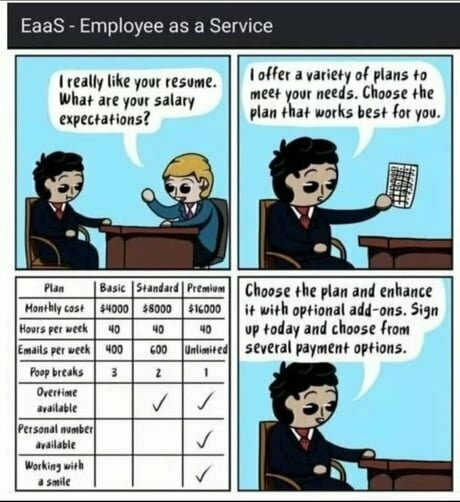
Source: EaaS : ProgrammerHumor
'Slack' and work
I’m composing this having done about 19 paid hours of work this week. I’ve also contributed to Open Source projects, written here, done some housework, parenting, and various other things.
I don’t define myself by paid work. I can’t really even properly tell you what I ‘do’ for a ‘job’, to be honest.
According to Bertrand Russell, this is all well and good. As Andrew Curry notes in this post, we should be aiming for about 60% capacity at any given time. I usually end up averaging between 20 and 25 hours per week, so it looks like I’m doing OK…
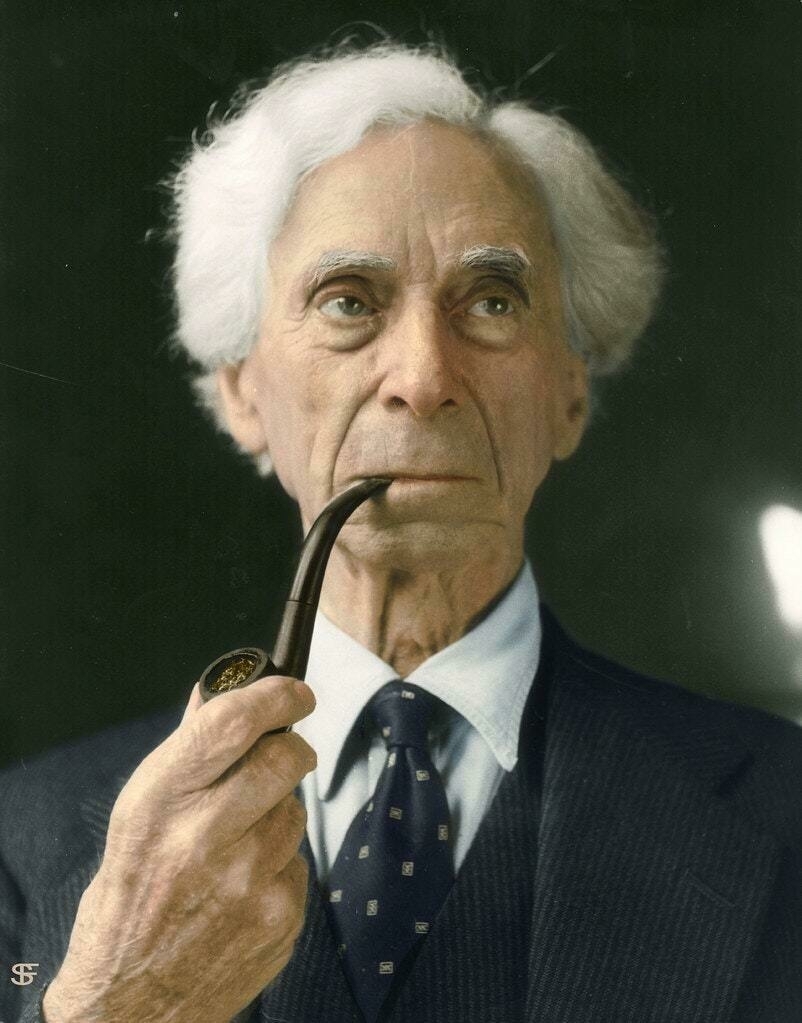
One of the key parallels that’s useful to draw here is between the idea of working less and ‘slack’. Slack is a difficult concept to pin down, but can exist in forms from queueing theory to buffer states. Working fewer hours than the current default 40-hour week is probably what most people do already, and it is also probably likely to move our slack-meter to a more optimal level.Source: 10 June 2022. Work | Dystopia | Just Two ThingsRunning with significant slack is often more efficient than running systems at high capacity. If you’re mathematically minded, Erik Bern simulates this via some code in the queueing theory link above, but G Gordon Worley III…gives a simpler explanation:
If you work with distributed systems, by which I mean any system that must pass information between multiple, tightly integrated subsystems, there is a well understood concept of maximum sustainable load and we know that number to be roughly 60% of maximum possible load for all systems.Allowing flexibility and time into our systems so that we can sit idle is not an admission of defeat, but instead has the potential to be optimal in many circumstances.This property will hold for basically anything that looks sufficiently like a distributed system. Thus the “operate at 60% capacity” rule of thumb will maximize throughput in lots of scenarios: assembly lines, service-oriented architecture software, coordinated work within any organization, an individual’s work, and perhaps most surprisingly an individual’s mind-body.
“Slack” is a decent way of putting this, but we can be pretty precise and say you need ~40% slack to optimize throughput: more and you tip into being “lazy”, less and you become “overworked".
I’m not sure how many working hours a week the dogma “operate at 60% capacity” translates to, but Bertrand Russell thought it might be twenty.
Art gallery mode
I love this post by David Cain so much. He talks about how every weekend during the summer he goes on a bike ride. Using an app to randomise his destination, he always finds something worth discovering. Why? Because he’s in what he calls ‘art gallery mode’.
To select a destination, I use an obscure app called Randonautica, which creates an X-marker somewhere on a map of the city. The app’s “About” section says it chooses this location through “theoretical mind-matter interaction paired with quantum entropy to test the strange entanglement of consciousness with observable reality.” It says the app’s users, when they arrive at their prescribed locations, often find “serendipitous experiences that seemingly align with their thoughts.”Source: How to Get the Magic Back | Raptitude[…]
The first time it sent me to a creekside clearing, where I saw a strange black glob in the water that turned out to be a mass of tadpoles. Another time it sent me to a gravel back lane near where I used to live, at a spot where someone had written “DAD!” on the fence in some kind of white resin. Another day it took me to a book-exchange box containing only children’s books and Stephen King’s Tommyknockers.
Wherever it sends you, there’s always something there that seems charged with a small amount of cosmic significance, even if it’s just a particularly charismatic patch of dappled sunlight, an abandoned shopping list with unusual items on it, or some other superordinary sight akin to the twirling plastic bag in American Beauty.
The trick here is that there’s always something significant, poignant, or poetic everywhere you look, if your mind is in that certain mode – so rare for adults — of just looking at what’s there, without reflexively evaluating or explaining the scene. A mystery co-ordinate in an unfamiliar neighborhood gives you few preconceptions about what you’re going to find there, so the mind naturally flips into this receptive, curious state that’s so natural for children.
I sometimes call this state “art gallery mode,” because of a trick I learned from an art history major. We were at the Metropolitan Museum of Art in New York, browsing famous abstract paintings by Pollock, Kandinsky, Mondrian, and other artists whose swirls, rectangles, and blobs are regarded as masterpieces.
The new digital divide
We’re already at the stage where most people in the developed world have a device that can access the internet in their pocket. Many families have multiple devices in their house that can access the internet. We’re getting to the stage where that’s starting to be the case in developing countries.
So the new digital divide? How we use the internet. I think there’s a lot to unpack here, especially as we live in unequal societies dominated by hyper-capitalism. It would be easy to victim blame, but I know from experience that when I’m burned out, all I want to do is stare and scroll at my phone…
In his seminar, Moro referred to the socio-economic divide based on how we use the internet as the second digital divide, in contrast to the original digital divide which was based on access to the internet.Source: The Digital Divide in How We Use the Internet | Irving Wladawsky-BergerGetting online in the 1990s required a personal computer and an account with a service provider, and e-commerce transactions required a credit card and bank account. As our economy was becoming increasingly digital, major new inequalities were now arising because so many around the world could neither afford a PC or an internet account and had no bank relationship or credit card. The reach and connectivity we were all so excited about in this initial phase of the internet era was in reality not so inclusive. While the internet was truly empowering for those with the means to use it, it led to a growing digital divide both within countries and across the world. The internet was ushering a global digital revolution, but it was disconcerting to have a global digital revolution that left out the majority of the world’s population.
This picture started to change in the 2000s. Continuing technology advances were now bringing the empowerment benefits of the digital revolution to a majority of the planet’s population. Mobile phones and wireless internet access went from a luxury to a necessity that most everyone could now afford, initially in advanced economies, and later in most of the rest of the world. We were transitioning from the connected economy of PCs, browsers and web servers to an increasingly hyperconnected digital economy of ubiquitous, powerful and inexpensive mobile devices, cloud-based apps, and broadband wireless networks.
While the original internet access gap is now minimal in developed economies, Moro and his collaborators found that a digital usage gap has now emerged, representing the distinct uses of the internet by different socio-economic groups based primarily on their income and educational status.
[…]
The study found quantitative evidence of a significant digital divide in internet usage between two socio-economic groups, each with different income and educational attainment. In principle, all individuals had access to the same internet. But, the study found that each group generally accessed its own distinct version of the internet, and their socio-economic behavior was thus influenced by the fairly different services and information that they were exposed to. By analyzing mobile traffic flows, the study identified the key services that each group accessed:
“The digital usage gap is so profound between low- and high-income or low- or high-education areas that it can be used to clearly distinguish between them or even identify the relative composition of these groups in a given area,” wrote the authors. “High-income areas or those with higher education attainability show a more pronounced utilization of mobile devices to consume news, exchange e-mails, search for information or listen to music. At the same time, they display a reduced use of some social media platforms or video-streaming services.
Image source: Robin Worrall
Optimising for feelings, ceding control to the individual
It would be easy to dismiss this as the musings of a small company before they get to scale. However, what I like about it is that the three things they suggest for software developers (look inward, look away from your screen, cede control to the individual) actually constitute very good advice.
So, if not numbers, what might we optimize for when crafting software?Source: Optimizing For Feelings | The Browser CompanyIf we’ve learned anything, it’s that all numerical metrics will be gamed, and that by default these numbers lack soul. After all, a life well-lived means something a little different to almost everyone. So it seems a little funny that the software we use almost every waking hour has the same predetermined goals for all of us in mind.
In the end, we decided that we didn’t want to optimize for numbers at all. We wanted to optimize for feelings.
While this may seem idealistic at best or naive at worst, the truth is that we already know how to do this. The most profound craftsmanship in our world across art, design, and media has long revolved around feelings.
[…]
You see — if software is to have soul, it must feel more like the world around it. Which is the biggest clue of all that feeling is what’s missing from today’s software. Because the value of the tools, objects, and artworks that we as humans have surrounded ourselves with for thousands of years goes so far beyond their functionality. In many ways, their primary value might often come from how they make us feel by triggering a memory, helping us carry on a tradition, stimulating our senses, or just creating a moment of peace.
Good ideas become colonised and domesticated
I’ve got this thought about how every good idea becomes colonised and domesticated. While domestication can be a good thing, because it potentially makes it more accessible to all, it also robs the idea of its radical, transformatory power.
Colonisation, however, is never a positive thing. It’s about renegotiating existing relationships, often through the lens of power, capital, and hegemonic power.
How related the above two paragraphs are to this article in The New Yorker is questionable. But, to me, it’s related. Centralised social media is colonised and domesticated.
Once upon a time, the Internet was predicated on user-generated content. The hope was that ordinary people would take advantage of the Web’s low barrier for publishing to post great things, motivated simply by the joy of open communication. We know now that it didn’t quite pan out that way. User-generated GeoCities pages or blogs gave way to monetized content. Google made the Internet more easily searchable, but, in the early two-thousands, it also began selling ads and allowed other Web sites to easily incorporate its advertising modules. That business model is still what most of the Internet relies on today. Revenue comes not necessarily from the value of content itself but from its ability to attract attention, to get eyeballs on ads, which are most often bought and sold through corporations like Google and Facebook. The rise of social networks in the twenty-tens made this model only more dominant. Our digital posting became concentrated on a few all-encompassing platforms, which relied increasingly on algorithmic feeds. The result for users was more exposure but a loss of agency. We generated content for free, and then Facebook mined it for profit.Source: How the Internet Turned Us Into Content Machines | The New Yorker“Clickbait” has long been the term for misleading, shallow online articles that exist only to sell ads. But on today’s Internet the term could describe content across every field, from the unmarked ads on an influencer’s Instagram page to pseudonymous pop music designed to game the Spotify algorithm. Eichhorn uses the potent term “content capital”—a riff on Pierre Bourdieu’s “cultural capital”—to describe the way in which a fluency in posting online can determine the success, or even the existence, of an artist’s work. Where “cultural capital” describes how particular tastes and reference points confer status, “content capital” connotes an aptitude for creating the kind of ancillary content that the Internet feeds upon. Since so much audience attention is funnelled through social media, the most direct path to success is to cultivate a large digital following. “Cultural producers who, in the past, may have focused on writing books or producing films or making art must now also spend considerable time producing (or paying someone else to produce) content about themselves and their work,” Eichhorn writes. Pop stars log their daily routines on TikTok. Journalists spout banal opinions on Twitter. The best-selling Instapoet Rupi Kaur posts reels and photos of her typewritten poems. All are trapped by the daily pressure to produce ancillary content—memes, selfies, shitposts—to fill an endless void.
Testing a 4-day work week
I already work what most people would call ‘part-time’, doing no more than 25 paid hours of work per week, on average. I’m glad that employers are experimenting with a shorter workweek (for the same pay) but inevitably one of the metrics will be ‘productivity’ which I think is a ridiculously difficult thing to actually measure…
“After the pandemic, people want a work-life balance,” Joe Ryle, the campaign director for the 4 Day Week Campaign, said in an interview. “They want to be working less.”Source: Britain Tests a 4-Day Workweek | The New York TimesMore than 3,300 workers in banks, marketing, health care, financial services, retail, hospitality and other industries in Britain are taking part in the pilot, the organizers said. Mr. Ryle said the data would be collected through interviews and staff surveys, and through the measures each company uses to assess its productivity.
“We’ll be analyzing how employees respond to having an extra day off, in terms of stress and burnout, job and life satisfaction, health, sleep, energy use, travel and many other aspects of life,” Juliet Schor, a sociology professor at Boston College and the lead researcher on the project, said.
Coffee and its impact on fitness
It’s good to read this, which is a side product of the excellent Just One Thing podcast.
I currently drink a couple of cups of coffee per (working) day — one at around 10:00 and the other at about 14:30. Given I often exercise in the middle of the day, this actually works out pretty well!
Studies have shown that coffee improves almost every aspect of sports performance, whether it's strength, explosive speed, endurance or skill.. Dr James Betts, Professor of Metabolic Physiology at the University of Bath, says: “I would put caffeine on top of the list of supplements that boost physical performance – both for the size of effect that you get, and the breadth.”Source: Can coffee make you fitter? | BBC Radio 4 - Just One ThingOne way that coffee boosts performance is by blocking the action of adenosine. Adenosine is a chemical messenger in your brain which makes you feel tired. Caffeine blocks the action of adenosine, helping you go on for longer without getting tired. “You could do worse than imagining adenosine to be like a brake that’s going to slow down your neural activity. Caffeine essentially hits the same receptors to prevent sleepiness,” explains Prof Betts.
Another way coffee works to boost exercise performance is by raising your levels of adrenaline, which can reduce pain and delay fatigue. It could also have effects on your fat and muscles.




